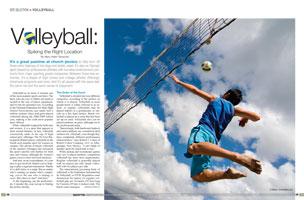
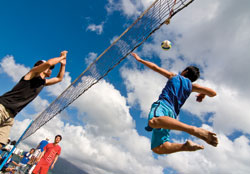 |
| © Wdeon - Dreamstime.com |
It's a great pastime at church picnics to help burn off those extra helpings of hot dogs and potato salad. It's also an Olympic sport played by professional athletes with lucrative endorsement contracts from major sporting goods companies. Between those two extremes, it's a staple of high school and college athletic offerings, intramural programs and more. And it's all played with the same ball, the same net and the same sense of enjoyment.
Volleyball as we know it remains one of the most popular sports out there. The basic rules are easy to follow, not much is needed in the way of player equipment, and it's fun for spectators too. According to the National Federation for State High School Associations, just under half a million students (boys and girls) played volleyball during the 2008-2009 school year, making it the sixth most popular sport offered.
While volleyball is played by both men and women, it is a sport that appears to skew toward females. In fact, volleyball consistently ranks in the top 10 high school girls' offerings. The NCAA's Participation Report places volleyball as the fourth most popular sport for women on campus. The advent of beach volleyball in the summer Olympics has increased the sport's profile still further for both men and women, although the women's games receive more televised attention.
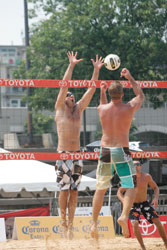 And now, as an event planner, it's your turn to get involved. Maybe you're helping to plan a regional tournament. Maybe it's a skill clinic or a camp. But no matter who's coming, no matter who's competing, you're the one who is hoping to score. But where to start? And how?
And now, as an event planner, it's your turn to get involved. Maybe you're helping to plan a regional tournament. Maybe it's a skill clinic or a camp. But no matter who's coming, no matter who's competing, you're the one who is hoping to score. But where to start? And how?
At the beginning, say the professionals. Consider this your set-up in finding the perfect facility.
The Order of the Court
Volleyball is divided into two different categories, according to the surface on which it is played. Volleyball as most people know it (often referred to as indoor, or regular, volleyball) may be played indoors in a gymnasium, or outside on a flat, hard surface. Beach volleyball is played on a court that has been set up on sand. Volleyball also can be played outdoors on grass, although not in the professional arena.
"Interestingly, both hardwood (indoor) and sand (outdoor) are considered ideal surfaces for volleyball, even though they have completely different performance characteristics," says Robert J. Cohen of Robert Cohen Company, LLC in Albuquerque, New Mexico. "I can't think of another sport for which that is true."
While pickup and recreational games may vary in player numbers, competition volleyball has more strict requirements. Regular volleyball is generally played with six players per side, beach volleyball with two players per side.
The international governing body of volleyball is the Federation International de Volleyball, or FIVB. Regulation court dimensions for indoor (or regular) volleyball play are 18 meters (59feet) long by 9 meters (29 feet, 6 inches) wide. The beach court measures 52 feet, 6 inches by 26 feet, 3 inches (16 meters by 8 meters). In both cases, the court is surrounded on all sides by a freezone (the space outside the sidelines) of 9 feet, 10.11 inches (3 meters). The free zone provides a safe overrun area for players. Courts should never be placed so close together that the free zone is compromised.
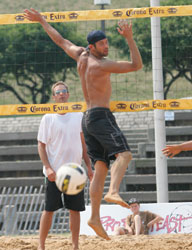 For both regular and beach volleyball, the space over the court must be free from any obstructions to a height of 7 meters (23 feet) from the playing surface. Note: Dimensions of the free zone and the overhead clearance required will vary at higher levels of competition, such as at the FIVB World level; always have your level of competition in mind when choosing a facility -- and use the most current version of the rules to ascertain if your chosen facility is in compliance.
For both regular and beach volleyball, the space over the court must be free from any obstructions to a height of 7 meters (23 feet) from the playing surface. Note: Dimensions of the free zone and the overhead clearance required will vary at higher levels of competition, such as at the FIVB World level; always have your level of competition in mind when choosing a facility -- and use the most current version of the rules to ascertain if your chosen facility is in compliance.
The height of the net will vary, depending upon the players. For men, the top of the net should be 2.43 meters (or 7 feet, 11 5/8 inches) from the floor. For the women, the top of the net should be 2.24 meters (or 7 feet, 4 inches) from the floor. In co-ed competitions, the men's volleyball net height requirements are used. Net height measurements are taken from the exact center of the top of the net to the floor of the court, or to the surface of the sand. The net's height at the sidelines cannot be greater than 3/4 inches off from the official height requirement. Net height requirements are the same for beach and regular volleyball.
"The volleyball net has to be very sturdy," says Alex Levitsky of Global Sport & Tennis Design Group, LLC of Fair Haven, New Jersey. "Some systems include guide wires that are fastened to the top of each post and triangulated into the floor or walls. This system is not recommended, as it creates a tripping hazard and has other possible safety issues. The preferred system is a post and sleeve and avoids guide wires altogether." In many indoor facilities, weighted bases for net posts also are used successfully to hold nets at a proper height. The net post to be used in your event will depend upon the set-up of your facility.
While there are specific rule differences and while the ball is slightly different, play is mainly conducted the same way for both regular and beach volleyball. (As a side note, the official rules of competition volleyball are extensive and may surprise amateur players with their complexity; however, the scoring system, rotation of players and basic techniques for moving the ball over the net are easily understood by most people and thus the sport remains popular on a recreational level.)
For both regular and beach volleyball, the event planner should be seeking out a venue that will accommodate all those who are involved. Look for a facility that has ample space around the playing area to provide adequate room for coaches, officials and other player personnel. Seating will need to be available for those people as well.
With sufficient space for multiple courts to be set up, a number of games can be played at once. If this is a skills clinic or player development camp, at least one 'arena' court should be available, so that all those in attendance can watch demonstrations of specific skills and techniques before splitting up to put into practice what they have learned.
Technical Details
Competitive athletes will require team benches, and safe places to store their bags, jackets and other gear. Showers, lockers and other amenities will contribute to the experience. In beach volleyball, players will appreciate a bench with a sunshade or umbrella that can be put up.
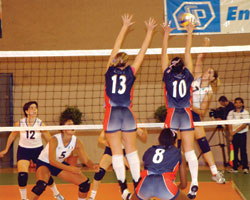 Lighting must be sufficient for the game to be played safely. While recreational volleyball can be played in normal lighting, higher levels of play demand higher levels of lighting, particularly any matches that will be televised. In addition, if you are planning an event where play takes place in an elimination format, and teams may play multiple games in one day, a well-lit facility can expand the playing day and allow each court to host more games.
Lighting must be sufficient for the game to be played safely. While recreational volleyball can be played in normal lighting, higher levels of play demand higher levels of lighting, particularly any matches that will be televised. In addition, if you are planning an event where play takes place in an elimination format, and teams may play multiple games in one day, a well-lit facility can expand the playing day and allow each court to host more games.
"The volleyball can travel as fast as 80 miles during men's collegiate or international play," notes Levitsky. "In addition, players are generally looking up during play. It is important to have lots of lighting, but also to have the lighting controlled in order to reduce glare and hot spots."
For outdoor play (including beach volleyball), where natural lighting will be a factor, Levitsky recommends finding a facility where courts are oriented in a north-south direction so as to allow for play throughout the day. (Courts that are oriented in an east-west direction will result in players on one side of the net having to face directly into the sun in either the morning or late afternoon hours.)
On the Surface
Although it goes without saying, the safety of competitors should always take priority in the selection of a venue. Surfacing for areas being considered for regular volleyball events should be free of imperfections, such as cracks, dips, bumps or anything else that could cause an athlete to stumble or fall. Gymnasiums or arenas with coated wood floors or coated cement floors, as well as indoor multi-sport areas are also good choices. Some may be lined for volleyball already.
"Volleyball players need to be able to lunge and slide, so shock absorption and a uniform coefficient of friction are important," says Robert Cohen. "What is most important concerning the composition of a competition volleyball surface is that it is uniform. Going from sticky to slippery indoors is dangerous, going from soft to hard is dangerous outdoors. Ball bounce is not a factor for volleyball. Competition volleyball surfaces are commonly made from synthetics, such as rubber, vinyl, or polypropylene. Indoor competition volleyball at the Olympic Games, for example, is played on synthetic floors, not hardwood."
For beach volleyball, the playing surface of the court should be made of leveled sand which is kept as flat and uniform as possible. Because most athletes play barefoot, the sand may not contain rocks, shells or other objects that could cause interference or injury during play. Sand should be raked regularly to remove foreign matter and even it out. Remember that beach erosion, wind and other forces (including passersby, animals and more) will displace sand and perhaps bring in contaminants.
While FIVB competition rules state that the sand must be at least 40 centimeters deep (about 15 and 3/4 inches) and made up of fine, loosely compacted grains, many recreational courts located on public beaches and in other municipal areas will have varying depths and compaction of sand.
Other Considerations
Define your needs: How much space is necessary? In tournaments with multiple games, you'll need room for all those games. In any event with an elimination format, fewer facilities are needed over time. Seek facilities with ample parking.
Officials: Game officials should know the rules for the sport with regard to the governing body and age group being hosted. The local high school or collegiate athletic association, rec council, etc., can help point you in the right direction. For an event being held during a busy sports season, officials' time should be reserved in advance.
Players' needs: While volleyball isn't an equipment-heavy sport (beach volleyball players generally wear swimsuits and no shoes, and regular/indoor players generally wear only knee pads and sport shoes in addition to their team uniforms), players will always require safe places to store personal property.
Seating: If this is a competitive event, and if it is not being held in a facility with bleachers, seating will need to be provided for spectators, media, etc. ADA considerations apply.
Conveniences: On-site rest rooms (or portable toilets and hand sanitizing stations) are necessary, as are changing areas and possibly refreshment stands.
Amenities: A public address system, score board, press box, etc., may be necessary.
Permitting: Make sure all necessary paperwork has been completed, including permitting for special events, road closures, etc.
Insurance: In any sporting event, insurance is critical. Speak with your legal counsel and your insurance advisor, as well as the facility management, to make sure all appropriate coverage is in place.
Emergency Facilities: Unfortunately, injuries and emergencies occur. Any venue should have a first-aid tent or office, and be accessible to emergency personnel.
What else?
Accommodations: Are there hotels, motels and campgrounds available? Even the best-run volleyball event will be complained about if accommodations are too far away.
What's Fun? All sporting events should be accessible to attractions that players, spectators and others can take advantage of during downtime. Of interest to youth might be areas with restaurants, malls and recreation like mini-golf, theme parks or water parks. Older players might prefer historical sites, cultural attractions or nightlife.
Ace your next volleyball event by knowing the rules of the game, the needs of the players and the requirements of the governing body. You'll spike your way to success.

